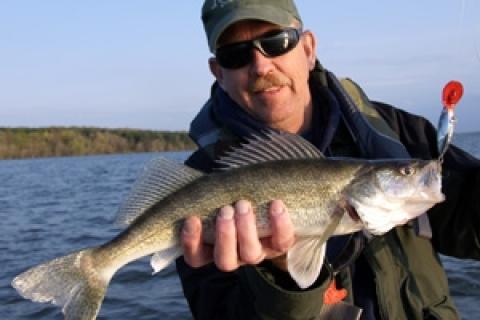
 With the rapid approach of fall, water temperatures are dropping. And the walleyes will be biting. One of the best ways of contacting walleyes is by trolling, particularly when you use a versatile approach that helps comb various water depths.
With the rapid approach of fall, water temperatures are dropping. And the walleyes will be biting. One of the best ways of contacting walleyes is by trolling, particularly when you use a versatile approach that helps comb various water depths.
Walleye trollers can increase their efficiency by employing a two-way system that uses both un-weighted flatlines and inline trolling sinkers, a versatile application that's particularly effective during the post spawn period, a time when fish can be scattered in a variety of depths.
Here's the deal: Set up trolling rods and linecounter level wind reels with 30-pound test braided line. The thin line diameter allows it to cut through water, enabling lures to reach their maximum depth. Tie a snap to the superbraid. Then tie a 6 to 8-foot trolling leader, with 10- to 12-pound test fluorocarbon line, with a snap on one end, a swivel on the other.
To work the shallower range, simply snap the leader onto the braid, then a shad-shaped crankbait to the snap. With 80 to 120 feet out, baits like STORM's Hot-n-Tot or Rapala's Shad Rap will get down to the 10- to 14-foot zone.
When it's time to check out the deeper zones, rather than rigging up with a whole new setup with lead core line, simply clip in a trolling sinker like Bass Pro Shops' Fish Weight Inline Fishing Weight between the superbraid snap and the leader swivel.
Experiment with both one- and two-ounce sinkers to reach the depths you desire given your boat speed. You'll be able to get down to those deeper zones without the bother of setting up with lead core line outfits, and will be able to make a quick switch should you decide to fish shallow later on.
Weighted lines are sensitive to speed of travel. When you're simply long-line trolling diving crankbaits, boat speed has little effect on diving depth of the lure. Add weight, by way of inline trolling sinkers, and the same is not true. Speed up and the lure runs higher (shallower); slow down and they sink to deeper water. That's why it's nice to have a GPS unit, even a simple one, which registers speed (called "ground speed" on most models). You can keep the boat moving at a consistent speed, an important aspect when you're trying to keep lures a foot or two from the bottom.
- 4186 views

